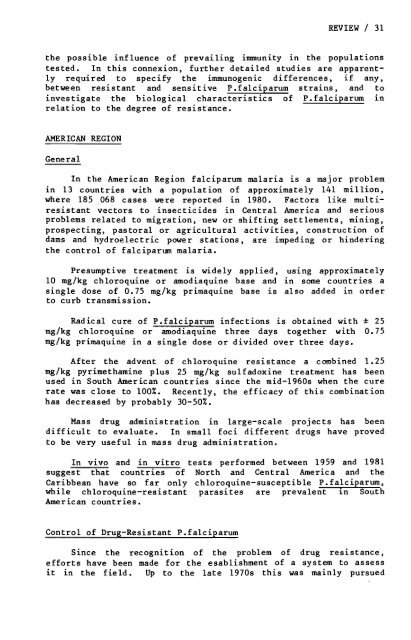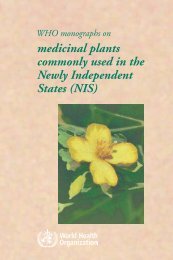Drug-Resistant Malaria - libdoc.who.int - World Health Organization
Drug-Resistant Malaria - libdoc.who.int - World Health Organization
Drug-Resistant Malaria - libdoc.who.int - World Health Organization
Create successful ePaper yourself
Turn your PDF publications into a flip-book with our unique Google optimized e-Paper software.
REVIEW / 31<br />
the possible influence of prevailing inununity in the populations<br />
tested. In this connexion, further detailed studies are apparently<br />
required to specify the immunogenic differences, if any,<br />
between resistant· and sensitive P.falciparum strains, and to<br />
investigate the biological characteristics of P.falciparurn in<br />
relation to the degree of resistance.<br />
AMERICAN REGION<br />
General<br />
In the American Region falciparum malaria is a major problem<br />
in 13 countries with a population of approximately 141 million,<br />
where 185 .068 cases were reported in 1980. Factors like multiresistant<br />
vectors to insecticides in Central America and serious<br />
problems related to migration, new or shifting settlements, mining,<br />
prospecting, pastoral or agricultural activities, construction of<br />
darns and hydroelectric power stations, are impeding or hindering<br />
the control of falciparurn malaria.<br />
Presumptive treatment is widely applied, using approximately<br />
10 mg/kg chloroquine or amodiaquine base and in some countries a<br />
single dose of 0.75 mg/kg primaquine base is also added in order<br />
to curb transmission.<br />
Radical cure of P.falciparum infections is obtained with ± 25<br />
mg/kg chloroquine or amodiaquine three days together with 0.75<br />
mg/kg primaquine in a single dose or divided over three days.<br />
After the advent of chloroquine resistance a combined 1.25<br />
mg/kg pyrimethamine plus 25 mg/kg sulfadoxine treatment has been<br />
used in South American countries since the mid-1960s when the cure<br />
rate was close to 100%. Recently, the efficacy of this combination<br />
has decreased by probably 30-50%.<br />
Mass drug administration in large-scale projects has been<br />
difficult to evaluate. In small foci different drugs have proved<br />
to be very useful in mass drug administration.<br />
In vivo and in vitro tests performed between 1959 and 1981<br />
suggest that countries of North and Central America and the<br />
Caribbean have so far only chloroquine-susceptible P. falciparum,<br />
while chloroquine-resistant parasites are prevalent in South<br />
American countries.<br />
Control of <strong>Drug</strong>-<strong>Resistant</strong> P.falciparum<br />
Since the recognition of the problem of drug resistance,<br />
efforts have been made for the esablishment of a system to assess<br />
it in the field. Up to the late 1970s this was mainly pursued
















